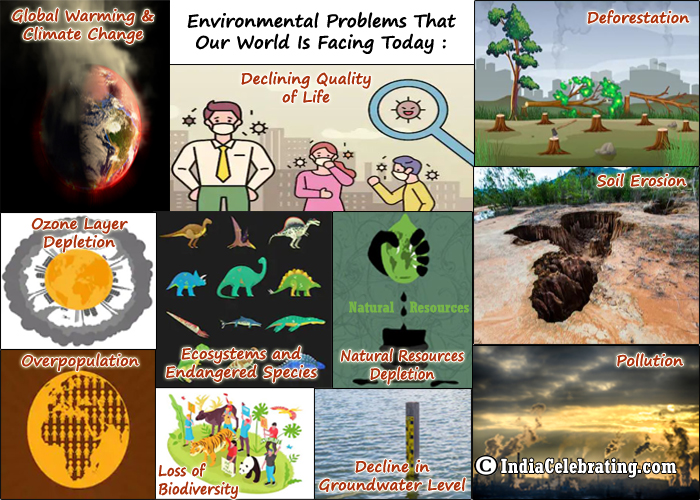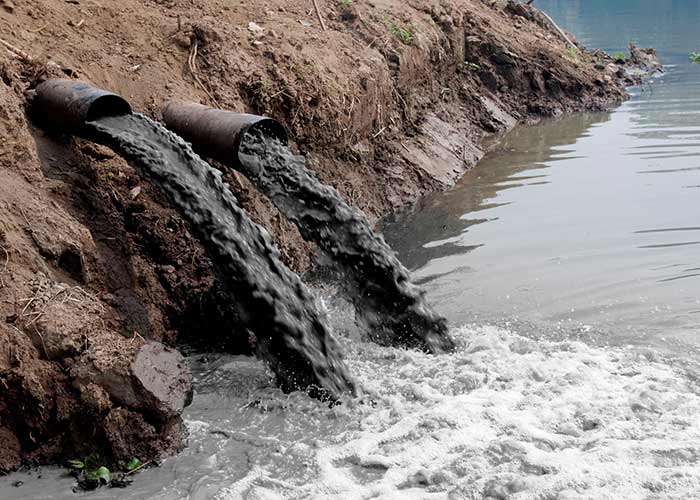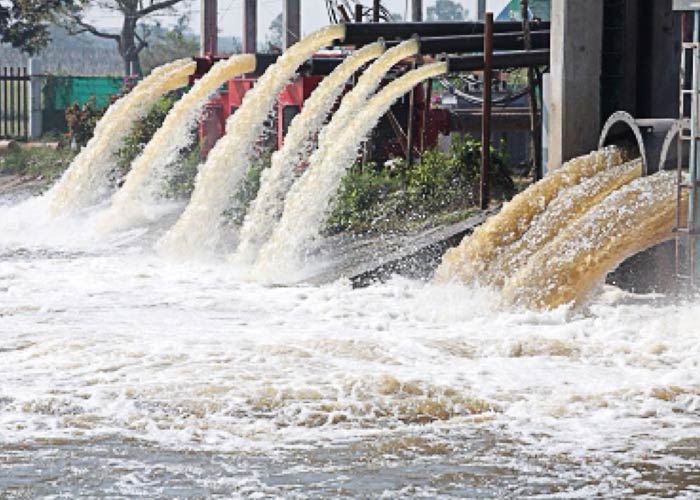We live in a habitat that comprises the sum total of all surroundings of living organisms including natural forces and species on land, air, and sea. All this constitutes environment.
The environment around us is constantly changing. As it changes, we need to become more aware about the problems those surround it. There are many environmental issues related to the problems with resources on the planet namely air, water, soil, etc. These problems have developed as a result of human interference or over-exploitation of Natural resources.
Increased human activities, urbanization, industrialization etc have greatly harmed the environment. The constant decline in environmental quality of the Earth and a considerable increase in the power and frequency of natural hazards such as cyclones, floods and droughts are making people vulnerable to food insecurity, ill health and unsustainable livelihoods.
People these days are facing newer and more challenging environmental problems all over the world.
While some of them may only affect a few ecosystems, others have the potential to drastically change the existing landscapes. If we do not address these issues on a priority basis, we are certainly doomed for disaster.
Main Environmental Issues – the World is Facing Today
Let us have a look and know more about some of the major environmental issues that the world is facing today.
1. Global Warming and Climate Change
Continuous increase in the earth’s temperature is called global warming. Our Earth receives heat from the Sun rays which pass through the atmosphere and collide with the surface of the earth, and then they are reflected back from there. The earth’s atmosphere is made up of several gases, including greenhouse gases. Greenhouse gases increase the temperature of the earth by absorbing the heat going out of the earth, which means longitudinal radiation, this process is called ‘greenhouse effect’. Greenhouse gases mainly contain carbon dioxide, methane, ozone etc.
Prior to industrialization and burning of fossil fuels, normal activities of humans did not had any significant increase in greenhouse effect. But during the period from 1880 to 2012, the average surface temperature of the earth increased by 0.85° C. During the period of 1906 to 2005, the earth’s average temperature recorded an increase of 0.74 ± 0.18° C.
Climate change is a very serious environmental problem that occurs due to rise in global warming. Apart from melting of polar ice and change in seasons, climate change has many harmful effects like occurrence of new diseases, frequent floods and change in the overall weather scenario.Due to climatic change, not only the temperature of earth is steadily increasing but the sea levels are also rising.
Therefore, the earth as well as oceans both is becoming warmer. In fact green house gases are a leading cause of climate change specifically those emitted from the man-made reasons. This causes an impact on habitats, agriculture, the ocean and natural disasters as well as unnatural patterns of precipitation such as flash floods, excessive snow, droughts or desertification.
The best way to reduce climate change is to work towards achieving sustainable development goals (SDGs) that alone can help us steer clear of any adverse impact on the environment. Using renewable energy sources such as solar and wind power goes a long way in waging a fight against climate change. Limiting waste and pollution levels also help preserve the environment.
2. Ecosystems and Endangered Species
In our planet, many things keep happening due to various environmental issues. In this process, both ecosystems and species get affected. It is feared that by 2050, one out of every ten plants and animal species are expected to go extinct from the earth. As ecosystems continue to decrease, we are going to lose the species that inhabit them.
For example, after almost a century of decline, now tiger numbers are on the rise but this species is still vulnerable to extinction. Another example in this context is polar bears. Rapid rise in the temperatures of the Arctic, resulting in the melting of sea ice, has been resulting in the elimination of habitat of polar bears.
Many organisations are dedicated to fight to save species from extinction. By upholding their cause, we will able to combat the threat of environmental degradation. Thankfully, there are certain laws in place and governments have also started acting accordingly to protect the ecosystems and endangered species.
3. Deforestation
Forests cover around 30% of the land. They are natural sinks of carbon dioxide and produce fresh oxygen and help us in regulating temperature and rainfall. Unfortunately, every year considerable forest cover is lost due to the growing population and its demand for more food, shelter and cloth in the wake of rapid urbanization.
Deforestation means loss of green cover in the process of making land available for agricultural, residential, industrial or commercial purposes. Forest is converted into agricultural land to make food available for the growing human population. Trees are also cut for timber, wood-fuel, animal-farm and many other purposes. Slash and burning agriculture, which is commonly called Jhum farming (cultivation) in the North-Eastern states of India, is also carried out where farmers harvest the trees of the forest and burn the plant remains.
More than 70% of earth’s plants and animal species live in forests. Due to continuous climatic changes happening all over the world, many species are losing their habitat and the ecosystems are dying out. There are fewer trees left to produce oxygen and absorb carbon dioxide because of deforestation. It is estimated that 15% of greenhouse gas emissions results from deforestation, and not from the burning of fossil fuels as it is generally believed.
Deforestation has a big impact on the world. Keeping the current situation in view, it appears that after a decade or so, we may have only 10% of the rain-forests left. The rest will be cut down for wood or wood pulp products or for agricultural uses.
The need of the hour is to preserve the remaining forests by stopping cutting of trees; and, if at all a tree is to be cut down, a new one should be planted immediately in its place.
4. Loss of Biodiversity:
Recent studies have found that loss of biodiversity as a result of climate change and pollution has a great impact on the planet’s ecosystem. Various kinds of human activities lead to the extinction of several species and habitats resulting in the loss of bio-diversity. If wild animals are killed for hunting, teeth, skin or other things, fisheries at the industrial level have been disturbing the balance of aquatic life. Every plant and animal on the earth is connected to other species. If this chain breaks down, survival will also be difficult for humans.
The existing ecosystems which took millions of years to become perfect are now in great danger. Threat to biodiversity implies that future generations will have to deal with increasing vulnerability of plants to pests and fewer sources of fresh water. The situation can be prevented if we leave native plants undisturbed and nurture landscape using native trees and vegetation.
Native plants are well adapted to the local conditions and provide low maintenance, drought resistance and prevention of floods. To keep a balance of natural processes, pollination is also quite crucial for the survival of Eco-systems.
Due to depleting biodiversity; food chain, water sources and other resources are under severe pressure. Without rich biodiversity, ecosystems deteriorate and after some time they no longer exist. Mankind can no longer afford the cost of biodiversity depletion and we need to take proactive measures to stop this.
5. Pollution:
One of the greatest problems that the world is facing today is environmental pollution, which is causing irreparable damage to the natural world and human society. Pollution is an undesirable change in the physical, chemical or biological characteristics of air, land, water or soil. Factors that cause undesirable changes are called pollutants.
In other words, pollution is the introduction of harmful substances into the environment as foreign substances especially contaminants or toxins produce very negative or harmful impact on plants, animals and human beings.
Pollution can take many forms such as in the air we breathe, in the water we drink, in the soil we use to grow our food, in the increasing noise we hear every day, and energy sources we consume as light and heat or solid wastes. All these contribute to various health issues and a lower quality of life with major disruptions and effects on wildlife and ecosystems.
We rely on air for respiratory requirements. They decrease the agricultural produce and due to them the plants die in immature state. Air pollutants have a very harmful effect on the respiratory system of humans and animals. Various industries, factories and combustion of fossil fuels through vehicles emit pollution in the air. Items like heavy metals, nitrates and plastic are toxic materials responsible for pollution. Electronic waste is another major pollutant. Nuclear waste disposal too has tremendous health hazards associated with it.
Human beings are misusing water and soil for disposal of all types of wastes and effluents, which are hazardous for ecosystem. High concentrations of toxic chemicals (pollutants or contaminated substances in the water and the soil play havoc with the environment.Effluent emissions from industries, factories, refineries ,waste treatment plants etc. degrades the quality of both water and soil.
In order to restore the quality of air, water, and soil, it’s essential to effectively combat pollution. In caring for the ecosystems, making sustainable choices and limiting the number of resources used, lies the potential for overcoming environmental problems.
6. Natural Resources Depletion:
Human civilization has greatly advanced with invention of many things that have made our lives easier. But as a result, resources are depleting faster than they can replenish themselves. Therefore, natural resource depletion has become a very critical environmental problem. It calls for making vigorous efforts on part of all of us to shift to using renewable sources of energy like solar, wind, bio-gas and geothermal energy.
Natural resources like water, coal, oil, natural gas and phosphorous etc., are facing continuous decline. We see water everywhere as our planet is 70% water but unfortunately out of this only 2.5% is fresh water. Rest of this is salt water which is not useful to human beings. This small percentage of fresh water is mostly in the form of ice or permanent snow cover. So, we need to protect the limited supply of fresh water against many forms of contamination.
Coal is among the most used fossil fuels and also a non-renewable energy source. Few years back, it was estimated that we have enough coal to meet global demands for the next 20 decades. However, as the demand for coal is continuously on the rise, its supply is bound to run short in the near future.
It is felt that without oil, global transportation will be severely debilitated. If our current demand continues, the available oil will be enough to supply the world demand for the next 46 years only. As per another estimate, the known reserves of natural gas are estimated to last up to the next 58 years only as per the current global production.
Phosphorous is derived from phosphorous rock and guano. It is a very important element that is used in the production of fertilizers to help plants grow. As per recent estimates by researchers, resources for phosphorous will also start declining after a decade or so.
7. Ozone Layer Depletion
Ozone layer is a protective layer in the stratosphere. Deficiency starts when ultra violet rays of the Sun (CFS gases) disintegrate the ozone layer. Chlorine atom is emitted by this process of disintegration. Chlorine reacts with ozone by which a chemical cycle starts which destroys the good layer of ozone in that area. Ozone layer has suffered considerable damage in recent times.
8. Soil Erosion
Due to the use of excessive manure, one-sided farming and excessive cutting of trees, the quality of soil around the world is continuously declining. According to the UN, every year 12 million hectares of land is rendered waste.
9. Decline in Groundwater Level
Declining ground water levels is the biggest threat to food security and livelihood across the world. According to reports, excessive exploitation of limited groundwater resources for irrigation of cash crops has greatly reduced the availability of water in ground. Low rainfall and drought are also the main reasons for decline in the ground water level.
10. Overpopulation
The world population is continuously rising resulting in considerable decrease in resources available for the survival of mankind. It is expected that our planet cannot support more than 10 billion humans and we are just a century away to reach that point. Thus, overpopulation is acquiring alarming proportions day by day.
With the increase in human population, greenhouse gases and climate change will only worsen. More the people on the planet more would be the release of carbon dioxide and other greenhouse gases into the air. However, it is a matter of relief that renewable energy sources, a great way to combat carbon emissions, are becoming increasingly popular.
The resources needed by increasing population can be sustainably sourced by raising the amount of sustainable energy such as wind power and solar power thus reducing carbon emissions in the air.
11. Declining Quality of Life
All the major environmental issues that the world is facing today are ending up into one central concern, that is, public health. All type of pollution, water scarcity and over-population present a clear threat to the health of people at large. According to one survey undertaken by the World Health Organization (WHO), nearly one out of every four deaths each year is directly caused due to unhealthy environment.
No doubt, the health and wellness of human beings is an important concern. For this, what we eat, drink and breathe in, play a significant role towards achieving and maintaining good health.
Dirty water is the biggest health risk posing a grave threat to the quality of life and public health. Dash-off to rivers carries toxins, chemicals and disease carrying organisms. These pollutants cause serious respiratory diseases like asthma and cardiac-vascular problems. Added to this, lack of hygiene and sanitation encourage the spread of infectious diseases.
Conclusion
The impact of human activities on the environment around us cannot be brushed aside. Climate change and many factors that contribute to carbon emissions could assume catastrophic proportions in the future. Polluted air and contaminated water are critical issues that need to be addressed on a war footing.
We need to find out the ways to stop depletion of natural resources from the planet. There is increasing thrust on developing sources of renewable and sustainable energy such as solar, wind and hydro power. These are natural, renewable and clean sources of energy. These resources will help us sustain the environment.
Integration of economic development and environmental protection to promote sustainable development is of paramount importance. The progress in this direction will certainly reduce the current environmental degradation. It will be worthwhile for people of the world to nurture their healthy social and cultural traditions and practices to improve the environment.
To achieve the goal of improving the environment, an appropriate examination should be undertaken to incorporate the old practices in the new pattern of development. The good news is that many of these issues can be controlled by making collective efforts by each country that will have a direct and positive impact on the global environment.The old saying “the whole is more than the sum of its parts” really holds true when it comes to the preservation of environment.







